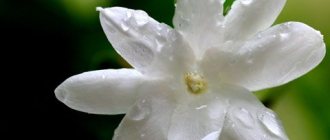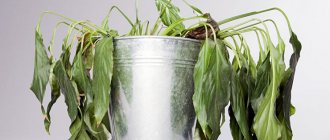Crocus (Crocus), or saffron, is a genus of bulbous herbaceous plants that belongs to the Iris family. In the wild, this plant is found in Southern, Central and Northern Europe, the Middle East, the Mediterranean, Central and Asia Minor. Crocuses prefer to grow in forests, steppes and meadows. There is a description of 80 species of this plant, as well as 300 varieties. The name "crocus" comes from a Greek word that translates as "fiber, thread." The name “saffron” comes from the Arabic word meaning “yellow”, this is because the stigmas of the flowers are exactly that color. Mention of this plant was found in Egyptian papyri; both doctors and philosophers wrote about crocus. These days, this plant is also very popular among gardeners, because it is one of the most beautiful primroses (early spring flowers). But few people know that there are a large number of species of such plants that bloom in autumn.
What does a flower look like, description
Belongs to the Iris family and is a herbaceous, bulbous, small flowering plant . Sometimes crocus is called saffron.
Under natural conditions, you can find primroses in the European part of the Eurasian continent, in the Middle East and Mediterranean, as well as in Central and Asia Minor.
The flower prefers hillsides , meadows, steppes and forest edges to live.
Saffron is not tall - its maximum height does not exceed 20 cm , usually the stem size is about 15 cm. It has a small (about 3 cm in diameter), slightly flattened bulb-rhizome, from which short fibrous roots appear.
The goblet-shaped crocus bud appears earlier than the arrow-shaped linear leaf blades.
Petals of single flowers have a wide range of colors:
- cream;
- white;
- blue;
- orange;
- yellow;
- purple.
There are varieties whose petals are colored in two shades at the same time.
Flowering duration can reach 20 days , but on average it is about 2 weeks.
A flower with a long history
Crocuses have been known since ancient times. Mentions of them are found in ancient Greek myths. In China, yellow dye was extracted from saffron for imperial clothing. It was grown in Egypt, Assyria, and India. Residents of European countries have long been familiar with saffron. And the crocus plant was brought to Russia in several ways at once, from Europe and Asia.
Historical documents contain information about saffron of both a poetic and practical nature. To awaken noble feelings, it was recommended to look at a crocus flower. Its dried stigmas were used as a seasoning, a pigment for making paint and golden varnish, and medicine.
Today, saffron is one of the most expensive spices because it is still harvested by hand. Sometimes manufacturers replace expensive saffron partially or completely with turmeric, which is much cheaper.
Doctors today are researching its antitumor properties. It is believed that an antidepressant can also be obtained from saffron.
Spring-blooming types of crocuses with photos
The entire variety of crocuses is divided into 15 groups: 14 of them contain varieties and species that bloom in spring, and the last one includes crocuses that bloom in autumn.
Spring (Crocus vernus)
Quite large, compared to other representatives of the genus, flower . Its height can reach 17 cm. The corm is small, slightly flattened, capable of producing two arrows at the same time.
The flowers are quite large, shaped like a tulip cup. The color of the petals is rich lilac or creamy white.
Two-flowered (Crocus biflorus)
Under natural conditions, this flower can be seen in the Caucasus , Crimea and territories from Iran to Italy.
It is characterized by a double color of the petals - longitudinal stripes are located on a white background, and the shades of the stripes may vary depending on the area where the crocus grows .
Golden (Crocus chrysanthus)
You can meet the flower on the Balkan Peninsula and in the territories of Asia Minor. The plant is quite large , its height only slightly reaches 20 cm.
The corm is small, flattened, and has a nearly spherical shape. The belt-shaped leaf plates are very narrow, rich green in color. The petals are slightly bent back; Their color is most often white and golden yellow .
Tomasini (Crocus tommasinianus)
This species can be found in natural conditions in Hungary and the countries of the former Yugoslavia. Crocus flowers adorn the hillsides and edges of deciduous forests.
The petals are a delicate lilac-pink shade , while the throat of the flower is painted white. It is noteworthy that one bulb can produce up to three arrows, and each will bloom. The height of the crocus is quite small, about 6 cm.
Features of crocus
Crocus is a low-growing plant, the height of which, as a rule, does not exceed 10 centimeters. The bulbs reach 30 mm in diameter and have a round or flattened shape. The surface of the bulbs is covered with scales, and they also have a bunch of fibrous roots. Shoots of such a plant do not grow. During flowering or after it, narrow linear basal leaf plates grow, they are collected in a bunch and covered with scales. Single goblet-shaped flowers reach 20–50 mm in diameter. The flowers can be colored cream, purple, yellow, white, blue, purple or orange. They bloom on a leafless short peduncle and are surrounded by membranous scales. There are varieties whose flower colors are two-tone or spotted. The duration of mass flowering is from 15 to 20 days. All types and varieties of this plant are divided into 15 groups.
Caring for crocuses. Secrets of abundant flowering
Blooming in autumn
These crocus varieties open their buds in autumn .
Lovely (Crocus speciosus)
You can see the beautiful crocus blooming in the Crimea, the Balkans and Asia Minor. For life, the flower chooses forest edges and mountain slopes.
The characteristic color of the petals is violet-pink with purple longitudinal thin veins . Flowering begins literally from the first autumn days and lasts up to 3 weeks.
Based on this variety, garden hybrids with white, lilac, deep blue, dark blue and soft purple petal colors were obtained.
Pretty (Crocus pulchellus)
The flower petals are lavender with thin longitudinal purple stripes, which makes the corollas brighter and more attractive. The height of the bush does not exceed 10 cm .
Banat (Crocus banaticus)
The crocus received its name in honor of the historical region of Romania, Banat, where it was found in the wild. It should be noted that this variety is generally widespread throughout the Balkans.
The height of the flowers does not exceed 14 cm, while the length of the silver-green leaf plates can reach 15 cm. The petals are pale lilac, with bright yellow anthers located in the center of the flower calyx .
Large-flowered Dutch hybrids
The history of Dutch hybrids begins in 1897, when the first plants were obtained. Now about 50 hybrids are known, which are divided into groups according to color:
- White flowers;
- purple, lilac and lilac flowers;
- The petals, in addition to the main tone, have a pattern of stripes or mesh.
Reproduction
Tubers
Crocuses have the ability to spontaneously reproduce by tubers growing in the ground. In principle, there is no need to interfere with this process, admiring the extravagance of Mother Nature. However, it happens that over time, large clusters of crocuses become very concentrated, and the flowering is clearly poorer.
In this case, it is recommended to dig up the tubers immediately after flowering and carefully divide the merged groups into smaller parts. The separation of daughter tubers from the main tuber, which usually begins to rot, is called vegetative propagation. In June or July, after the leaves have dried, the bulbs are dug up, dried for several days at a temperature of about 20-25 ° C, cleaned and separated, and planted in the fall or spring. Usually several bulbs are obtained from one.
The bulbs can be planted in their original place - at intervals of 15 cm, the rest can be used to decorate other parts of the garden.
The resulting tubers can be planted in pots in soil enriched with compost. If you can avoid unnecessary watering, such a pot will become an elegant decoration for windowsills or balconies.
Seeds
Sowing seeds is another way to propagate crocuses. Seeds can be obtained from fruits obtained from flowers, which are multi-seeded capsules. You can buy crocus seeds at the store. In autumn, the seeds are first sown in a container with appropriate soil, lightly compacted, and sprayed with water. The container is covered and placed in a cool, ventilated place. Grown plants are planted when they become capable of flowering - after about 3 years.
Garden crocus, planting and care
This is not to say that crocus is particularly capricious, but following the basic stages of planting and care will help you grow a healthy, strong plant.
Boarding time
Planting dates are chosen in accordance with the flowering time of saffron. Thus, it is recommended to plant plants that bloom in autumn in the ground in the spring , when the ground is free of snow and has warmed up a little.
It is not recommended to plant bulbs in damp, poorly warmed soil. This will lead to the development of rot and subsequent death of the planting material.
The optimal time for spring planting is April.
Varieties that bloom in spring are planted in autumn. The bulb must take root before the onset of cold weather , so planting is planned about a month before the first frost.
Landing place
Basic requirements for the planting site:
- Most crocuses prefer open, well-lit areas.
- Do not plant bulbs in low-lying areas where there is a high risk of stagnation. Although crocuses love moderately moist soil, the accumulation and long retention of water in the root zone will lead to the development of putrefactive processes, which will inevitably cause the flowers to die.
- Try to protect planting material from rodents; choose a planting site away from burrows and other habitats of such pests.
Soil requirements
Crocuses grow well on loamy and sandy soils that are neutral in acidity and moderately loose.
To further loosen the soil, you can add sand when digging , and lay fine gravel at the bottom of the planting holes.
Forcing
If planted at home, the bulbs can be planted in winter. This procedure is called forcing, its task is to grow the flower before planting it in the ground in order to get flowering in the spring.
How to grow in pots
For forcing, the bulbs are planted in a pot . It is permissible to plant 5–10 bulbs of similar size in one container.
Dutch large-flowered varieties are best suited for forcing.
The pot is selected in such a way that it can easily accommodate all the bulbs, but at the same time it is not too deep and must have a drainage hole to remove excess moisture. For planting, use a loose neutral substrate that allows air to pass through well.
Trimming
After the corolla of the flower dries out (this happens around the end of the third week of flowering), many novice gardeners try to cut off the peduncle along with the leaves. This is mistake.
Although flowering has stopped, the active phase of plant development has not yet been completed, and the leaves should not be touched.
You can carefully remove the flower arrow , but the leaf plates must be left, because they are the ones who provide nutrition to the bulb.
Requirements for the site, soil
Crocuses love sunny areas, but can also grow in partly sunny garden beds. This is not only a place where the snow melts quickly, but also an ideal environment to provide the bulbs with energy for early growth.
The soil should be well-drained, permeable, sufficiently moist, easily heated, not loamy, preferably with a neutral acidity level of 6.0-7.0 pH.
Crocuses planted in an area where there is stagnant water will not bloom, so you should carefully choose the planting site.
Advice. It is worth watching how water flows from the ground after heavy rain. If, a few hours after precipitation, puddles of rainwater are visible on the ground, this is a sign that you need to choose another place.
The bed should be enriched with organic compost, which provides the bulbs with the necessary nutrients immediately after planting. Too heavy soil must be mixed with sand and peat.
Crocuses planted on light, sandy and poor soils give little growth and may not bloom.
It is worth providing fertile soil, due to which the flowers will be more lush.
Photo. Large-flowered crocus "Joan of Arc"
When does it bloom and how to care after flowering
Crocus blooms in spring or autumn . After flowering has finished, the bulbs can be dug up, but this does not need to be done every year.
It is quite enough to remove the tubers once every 4–5 years. This procedure will prevent the development of fungus, as it allows the bulbs to dry.
Bulb storage
Store planting material in a well-ventilated area at a temperature of 17...19 °C.
Wintering
Spring-flowering plants tolerate winter frosts well and do not require shelter for wintering. They are dug up only once every 4–5 years to dry.
Autumn varieties are more sensitive to low temperatures, but they do not need to be dug up every year. After flowering, the flowerbed is mulched with bark and sprinkled with additional snow . Such a shelter will help preserve the bulbs and prevent them from freezing.
How to plant crocuses correctly. Our best varieties
These amazing spring flowers are the first to emerge from under the yet-melted snow cover and literally dazzle everyone around them with their unique bright beauty.
Crocuses are magnificent in their multicolor and variety of shapes and colors. They salute with their bright flowers, notifying the whole world about the coming of spring!
Well, how can you manage on your site without these luxurious harbingers of the onset of the new summer season? And how much joy and sweet hopes they inspire in our souls! The end of winter, frost, cold!!!
Wake up! The crocuses are blooming, which means spring has come!
Many amateur gardeners are wary of planting crocuses on their plots. For some reason, they consider these flowers capricious, requiring too tedious care.
However, this is not true at all! Crocuses are absolutely unpretentious if they are planted correctly and provided with minimal but strictly timely care.
At your request, today we will talk in detail about the most beautiful spring flowers, tell you how to properly plant delicate and amazing crocuses and how to care for them.
In addition, we will tell you which varieties of crocuses are best to plant in your garden so that these flowers will delight you and delight your neighbors.
HISTORY OF THE APPEARANCE OF CROCUS
This flower has another name - “saffron” (the name comes from the ancient Arabic word “zaferan”, which translates as “yellow”).
Yes, yes, that very expensive and necessary golden spice in cooking, which was used in ancient times to prepare various dishes for emperors and kings, was obtained from crocus pollen.
Saffron was used to make a surprisingly bright golden-yellow dye, which was used to dye fabrics intended for the clothing of the Lords of the Eastern countries. Their shoes were also painted with the same paint.
By the way, believers were sure that Buddha’s golden robe was also woven from saffron threads. This is why Buddhists prefer yellow in their attire.
India, the Middle East and Asia Minor are considered to be the birthplace of wild saffron. He was well known in Ancient Egypt and Ancient Greece even before our era.
In the ancient papyri of Homer, Hippocrates, and the books of Solomon, saffron is mentioned as a valuable medicine that cures many diseases and prevents aging.
Ancient doctors used it to try to create the Elixir of Eternal Youth, the recipes of which, unfortunately, have not reached us.
The progenitor of all crocuses was Cartwright's Mediterranean crocus, which, as a result of mutation, gave the world the first cultivated variety of this flower.
Dutch breeders were the first to start breeding crocuses and succeeded in creating unique varieties of bulbous tulips. They managed to breed a whole series of crocuses of amazing beauty, the bulbs of which they sold for huge money to other countries, including Russia.
BIOLOGICAL FEATURES OF CROCUS
Crocus is a small-bulbous perennial plant belonging to the Iris family. Its underground part is a flattened corm with ordinary scales, the basis of which is a thick tuber (modified stem).
To date, scientists have counted more than 75 species of crocus, among which there are long-flowering (in tropical climates), autumn-flowering (for more southern regions) and spring-flowering, which are most suitable for cultivation in most regions of our country.
In this article we will talk specifically about spring-blooming crocuses.
Depending on the weather, crocuses bloom in late March - early April, appearing directly from under the snow, when the already quite bright, warm sun begins to heat the ground.
When flowering, a short peduncle appears directly from the corm. A huge bud consisting of six petals blooms at its end. The height of the flower does not exceed 10 cm. Flowering can last up to three weeks (the duration depends on the variety).
As a rule, the flower shape of a crocus is goblet-shaped, however, as a result of selection, numerous varieties with a star-shaped, spherical and oval shape were bred, not only simple ones, but also double ones.
The coloring of the flowers simply amazes the imagination with its wide palette and bright colors. As a rule, each variety is multi-colored, although there are also monochromatic, but very bright representatives.
Crocus leaves are narrow, emerald green with a white stripe down the middle. They appear after the start of flowering, and create an amazing delicate frame for the flowers blazing with different colors.
Blooming crocuses easily tolerate spring frosts down to -8 degrees and are not afraid of even heavy snowfalls. Covered with snow, they seem to freeze and wait for the bright rays of the sun to melt this white blanket and reveal to the world the miracle of their second birth and the celebration of spring!
HOW TO PLANT CROCUSES CORRECTLY
Spring-blooming crocuses are planted only in autumn!
Landing dates. Depending on the region, planting dates may vary. The main condition is that the air temperature during the day should not exceed + 7 degrees. And before the onset of negative temperatures there should be at least 4 weeks.
This is exactly how long it takes for the bulbs to fully take root in a new place. However, you can’t rush either, since if planted too early, the crocuses may develop young sprouts, which, of course, will freeze in the winter along with the corm.
Approximately, crocuses are planted from September 20 to October 10.
Choosing a landing site. For crocuses, as well as for all other primroses, choose the sunniest, most elevated place, well protected from cold winds and drafts.
Make sure that snow does not accumulate in this area in winter, since during the spring melting the abundance of water and dirt will make it difficult for the crocuses to bloom early.
Soils . Crocuses need light, very fertile soil, rich in organic matter and well permeable, with a neutral reaction of the environment.
Crocuses will not grow on heavy clay and acidic soils. Therefore, these must first be neutralized using dolomite flour or crushed chalk (at the rate of 2 kg per 5 sq. m).
Landing. A week before planting, dig up the flower bed prepared for planting crocuses again.
For digging, add (per 1 sq. m): 2 buckets of humus or compost, 2 buckets of river sand, a bucket of leaf soil, half a bucket of wood ash, 2 tbsp. spoons of double superphosphate, 1.5 tbsp. spoons of potassium sulfate and a glass of dolomite flour (on acidic soils).
Loosen the surface of the flower bed well so that there are no lumps on it.
Grow crocuses in one place for no more than 4 - 5 years, otherwise the corm will become overgrown with children and may stop blooming altogether. But by the age of 4, the flowers will become much smaller and lose the brightness of their colors.
It is very important to choose the correct planting depth. Corms that are too deeply buried may not have enough strength to release the flower out.
Planting depth primarily depends on the size of the corm and the composition of the soil. For large corms on light soils, dig holes 9–10 cm deep, for children – 4–5 cm. When planting on denser soil, reduce the depth by 1.5–2 cm.
The distance between large corms is 8–10 cm, between children – 5–6 cm.
Crocuses planted in flower beds are not watered so that they do not wake up and begin to grow.
Shelter for the winter. When negative temperatures set in steadily in the fall, fill the flowerbed with crocuses with a 40 cm layer of dry fallen leaves. Place spruce spruce branches on top in two layers, “needles up”, so that mice and voles do not get to the delicious sweet bulbs.
When severe cold occurs in a snowless winter, place a double layer of dense covering material on top of the spruce branches, securing its ends well along the edges.
In winter, be sure to trample the snow around the flowerbed so that the ubiquitous rodents do not get to your plantings under it.
THE BEST VARIETIES OF CROCUSES FROM OUR COLLECTION
Now that you know how to plant crocuses correctly and how to organize their care, we suggest you choose the best varieties from our collection for planting on your site.
These are the most beautiful and fashionable varieties of spring-flowering crocuses that will amazingly transform your spring garden and make it look like a beautiful fairyland.
Our collection
Herald, Pickwick, Kochi, Vengrad, Grand Maitre, Bronze Zwanenburg, Ruby Giant, Pearl by the Sea, Pastel Set.
You can read more about these varieties on our website or in the “Autumn 2020” catalogue.
And you can buy them from us today!
Crocus at home: planting and care
Crocuses can be grown at home on a windowsill . Their early flowering will fill the apartment space with a delicate spring aroma.
Choosing a pot
Group plantings of different varieties of saffron in one container look great. The container is chosen in such a way that it can accommodate the onions without allowing them to come into contact with each other, but at the same time it would not be too high.
The material of the pot is not so important; disinfection of the container is important.
The pot is thoroughly washed with soap and doused with boiling water. The procedure is recommended for both new and used containers.
This measure helps prevent the spread of fungal spores and subsequent infection of the bulbs.
Watering
The bulbs need to be watered regularly, but in moderation. The next watering is carried out only after the top layer of soil has dried . Stagnant moisture and high humidity are detrimental to crocuses.
Lighting
For saffron to grow quickly, it needs a lot of sunlight . It is optimal to position the pot so that the sprouts are not exposed to direct sunlight, but the lighting is bright.
Place the pot of crocuses at some distance from central heating appliances. Too dry air also harms tender sprouts.
Humidity level
It is recommended to spray plantings only in very dry air . Moderate humidity combined with a stable temperature of about 15 ° C contributes to rapid flowering.
If the air in the room is too dry, you can place a bowl filled with water near the pot - this will help soften the atmosphere.
Top dressing
Crocuses are fed three times during the active growing season.
Saffron - uses of the plant
Dried saffron stigmas have long been used as a spice with a specific aroma and bitter taste. Today, 90% of the crop is grown in Iran. The spice is used in cooking for preparing rice, peas, and soups. It indicates a preservative effect, keeping the dish fresh for several days.
Information. In ancient times, saffron was valued more than gold and 15 times more expensive than black pepper. And not surprisingly, to prepare 1 kg of stigmas, it was necessary to manually process 200 thousand flowers.
Saffron stigmas are used in medicine. Compositions based on them have antispasmodic and stimulating effects. In folk recipes, dried stigmas are used as an analgesic and diuretic. They increase appetite. Medical properties are manifested due to the chemical composition of the plant. The following was found in the stigmas:
- essential oil;
- gum;
- vitamins;
- crocin dye;
- fatty oil;
- flavonoids.
The stigmas contain a coloring substance used in the food industry. The natural compound crocin allows you to give a yellow tint to cheeses, liqueurs, dough, and soft drinks.
Pests and diseases of crocuses
Common crocus diseases:
- fusarium;
- gray rot;
- penicillium rot.
Infection usually occurs due to planting healthy and diseased bulbs next to each other. If dark spots are found on the tubers, they should be sprinkled with wood ash .
Unfortunately, sometimes due to damage by thrips or aphids, flowers appear on the site, whose buds do not open completely and have a deformed, flattened shape.
These are symptoms of a viral disease carried by parasites. Unfortunately, it is pointless to treat affected plants ; they need to be dug up and burned. Insecticides are used as prevention.
Use in home and garden
Crocuses can have many functions in the garden, but look best in a form that mimics natural clumps. A spring lawn intertwined with colorful flowers looks fantastic, although the inconvenience of this solution is the restrictions on mowing the grass.
Crocuses planted in clusters under trees and on the edges of flower beds will become a wonderful colorful accent in early spring, when the garden is still quite gray and gloomy.
It is better to plant crocuses like tulips - in large beds or in rows, creating flower chains that will look great in the garden.
It is popular to plant crocuses in rock gardens and on slopes covered with sedum or climbing plants. They are not at all bothered by the company of other plants, so they can be used for spring compositions with early spring flowers:
- snowdrops,
- hyacinths,
- daffodils.
Experienced gardeners hide crocus tubers in the lower parts of the beds, between the plants, which later come to life and can cover gradually yellowed leaves.
Crocuses are not intended for cut flowers due to their delicacy and small size, but planted in pots they will decorate an apartment, terrace or garden plot.
Description of the plant and features
Crocus - what kind of plant is this? The beautiful crocus flower is a close relative of the most expensive spice in the world - saffron.
There are 80 species in nature, but only 14 varieties of crocuses are adapted for growing in the garden.
In their natural habitat, they are distributed throughout the world; references to flowers say that the first plants were discovered 3,000 years ago in the southern countries of Europe, in Asia, and the Alps in the 16th century.
Crocuses are corms. The size of the underground part in diameter is 3 cm. The corms are round, slightly flattened.
Thanks to a wide palette of colors, crocuses have won the hearts of gardeners. The plant is not tall, only from 5 to 15 cm. Huge cup-shaped flowers against the backdrop of such greenery look magnificent, just like in the picture. It is noteworthy that they also weaken the pleasant honey aroma. The only pity is that flowering is short-lived - 1-1.5 weeks.











